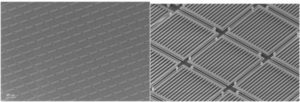Researchers: Byung-Wook Yoo
Funding Agency: Defense Advanced Research Projects Agency (DARPA)

Figure 1: Reflectivity spectra of highly reflective HCG compared to DBR. High reflectivity is obtained for TE-polarized light (polarization parallel to grating) over a broad wavelength band (1400-2000 nm), with a peak reflectivity of >99.9 % at 1550 nm wavelength where the beam is steered. For comparison: a reflectivity as high as 99.9% for a DBR typically requires 20 to 40 pairs of alternating index materials, resulting in ~100 times heavier reflector than an HCG.
Our high performance MEMS SWEEPER project will integrate innovative High Contrast Grating (HCG) mirrors and high-speed (10 MHz) MEMS actuation, to provide very high slew-rate, coherent beam forming in a low power, compact and lightweight package. The system acts as an array of dynamically tunable all-pass filters (APF). The optical phase of each array element is adjusted by physically changing the spacing of a Fabry-Perot cavity using a MEMS piston. This approach allows preshaping of the illumination distribution across the array aperture, resulting in beamforming and beamsteering..
Traditional liquid crystal optical phased arrays suffer from long relaxation times, slowing beam scanning to steps of tens of milliseconds. Conventional MEMS mirrors as optical phased arrays are either too heavy (e.g., bulk Si mirror or distributed Bragg reflectors) or suffer from temperature- or power-induced curvature change (e.g., micron-thick Si mirror with metal coating). The use of MHz-frequency MEMS and all-pass filters with HCG mirrors allows us to demonstrate sub-microsecond random access and scanned beam pointing with multiple independent beams.
We have developed a microelectromechanical system (MEMS) optical phased array incorporating a HCG for beamforming and beamsteering. Our approach needs only a thin single-layer HCG made of polysilicon, considerably improving its speed thanks to the low mass, and is suitable for high optical power applications. In particular, HCGs have become a subject of special interest regarding their very high reflectivity along a broad bandwidth, wider than distributed Bragg reflectors (DBR), as illustrated in Figure 1. The MEMS array comprises 32×32 of sub-wavelength HCG reflectors (Figure 2(a)). The size of the HCG is 20×20 um2 (Figure 2(b)). The spacing among HCG reflectors is 1 um, resulting in 92% fill-factor. The thickness, width and period of the grating are 400 nm, 570 nm and 1250 nm, respectively, which provide the HCG with the reflectivity of ~99.9%. The HCG is vertically driven by electrostatic force reflecting the incident light as well as creating the phase shift and coherent interference in the far field patterns. The measured beamsteering angle from the HCG optical phased array is ±2.12° as shown in Figure 3. The resonant frequency is 0.46 MHz.


